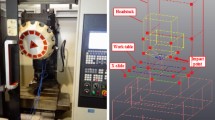Abstract
The structural vibration and dominant vibration characteristics of the machining process of machine tools have an important influence on the machining quality and efficiency. The dominant vibration characteristics are related to two factors: the dynamic characteristics of the machine tool structure and the excitation characteristics of the system. In the dynamic process of structural vibration, the participations of various modes in a certain frequency domain are often different in the vibration process; that is to say, not all modes can be excited equally, only a certain mode or some of the modes may play a major role in the specific processing conditions and dominate. Thus, these modes are called the dominant vibration modes. Therefore, this paper proposes a method of modal response signal prediction and dominant vibration mode identification under the cutting state of machine tool and studies the dominant vibration characteristics of the machine tool structure under cutting conditions. A dynamic system modeling method based on state space and modal decoupling theory is proposed. The Kalman filter algorithm is used to predict the modal response signal of the machine tool during cutting process, and the modal participation degree is analyzed based on the predicted modal response signal. In this way, the dominant vibration mode of the machine tool structure is analyzed.














Similar content being viewed by others
References
Zivkovic A, Zeljkovic M, Tabakovic S, Milojevic Z (2015) Mathematical modeling and experimental testing of high-speed spindle behavior. Int J Adv Manuf Technol 77(5-8):1071–1086
Neugebauer R, Scheffler C, Wabner M, Schulten M (2010) Advanced state space modeling of non-proportional damped machine tool mechanics. CIRP J Manuf Sci Technol 3(1):8–13
Gagnol V, Le TP, Ray P (2011) Modal identification of spindle-tool unit in high-speed machining. Mech Syst Signal Process 25(7):2388–2398
Zhou J, Mao X, Liu H, Li B, Peng Y (2018) Prediction of cutting force in milling process using vibration signals of machine tool. Int J Adv Manuf Technol 99(1-4):965–984
Richardson MH (1997) Is it a mode shape, or an operating deflection shape? Sound Vib 31:54–61
Schwarz BJ, Richardson MH (1999) Introduction to operating deflection shapes. CSI Reliabil Week 10:121–126
Schwarz B, Richardson M (2004) Measurements required for displaying operating deflection shapes. International Modal Analysis Conference XXII January 26:29
Dhupia J, Powalka B, Katz R, Ulsoy A (2007) Dynamics of the arch-type reconfigurable machine tool. Int J Mach Tools Manuf 47:326–334
Kushnir E (2004) Application of operational modal analysis to a machine tool testing. ASME 2004 International Mechanical Engineering Congress and Exposition. Am Soc Mech Eng Digit Collect 2004:57–62
Shi Y, Mahr F, Wagner U, Uhlmann E (2012) Chatter frequencies of micromilling processes: Influencing factors and online detection via piezoactuators. Int J Mach Tools Manuf 56:10–16
Li Z, Wang Z, Shi X (2017) Fast prediction of chatter stability lobe diagram for milling process using frequency response function or modal parameters. Int J Adv Manuf Technol 89(9):2603–2612
Tansel IN, Li M, Demetgul M, Bickraj K, Kaya B, Ozcelik B (2012) Detecting chatter and estimating wear from the torque of end milling signals by using Index Based Reasoner (IBR). Int J Adv Manuf Technol 58(1-4):109–118
Quanxin L (2017) Investigation on the vibration characteristics of machine tool structures in machining process and its effect on surface roughness. Dissertation, Huazhong University of Science and Technology
Dombovari Z, Iglesias A, Zatarain M, Insperger T (2011) Prediction of multiple dominant chatter frequencies in milling processes. Int J Mach Tools Manuf 51(6):456–464
Mascardelli BA, Park SS, Freiheit T (2008) Substructure coupling of microend mills to aid in the suppression of chatter. J Manuf Sci Eng-Trans ASME 130(1):011010
Siddhpura M, Paurobally R (2012) A review of chatter vibration research in turning. Int J Mach Tools Manuf 61:27–47
Seguy S, Dessein G, Arnaud L (2008) Surface roughness variation of thin wall milling, related to modal interactions. Int J Mach Tools Manuf 48(3-4):261–274
Wong SY, Chuah JH, Yap HJ (2020) Technical data-driven tool condition monitoring challenges for CNC milling: a review. Int J Adv Manuf Technol
Yenilmez A, Rincon D, Tansel IN, Erazo FI, Wang X, Chen P (2007) Estimation of the chatter zones of drilled holes by using s-transformation. Int J Adv Manuf Technol 31(7):638–644
Tsai S Y, Eman K F, Wu S M (1983) Chatter suppression in turning. Proceedings of 11th North American manufacturing research (NAMR) conference, Madison, WI, pp 399–402
Albrecht A, Park SS, Altintas Y, Pritschow G (2005) High frequency bandwidth cutting force measurement in milling using capacitance displacement sensors. Int J Mach Tools Manuf 45(9):993–1008
Wong WW, Erkorkmaz K (2010) Constrained identification of virtual CNC drives using a genetic algorithm. Int J Adv Manuf Technol 50(1):275–288
Salonitis K, Kolios A (2020) Force-based reliability estimation of remaining cutting tool life in titanium milling. Int J Adv Manuf Technol 106(7):3321–3333
Acknowledgments
This research is supported by the National Natural Science Foundation of China under Grant No. 51566004 and 51775210, and the Major special projects in Jiangsu Province of China under Grant No.SBE2017020146. The authors are grateful to other participants of the project for their cooperation.
Author information
Authors and Affiliations
Corresponding author
Additional information
Publisher’s note
Springer Nature remains neutral with regard to jurisdictional claims in published maps and institutional affiliations.
Rights and permissions
About this article
Cite this article
Huang, Q., Liao, J., Zhou, J. et al. Research on dominant vibration mode analysis of machining process of machine tools. Int J Adv Manuf Technol 109, 275–287 (2020). https://doi.org/10.1007/s00170-020-05654-7
Received:
Accepted:
Published:
Issue Date:
DOI: https://doi.org/10.1007/s00170-020-05654-7




